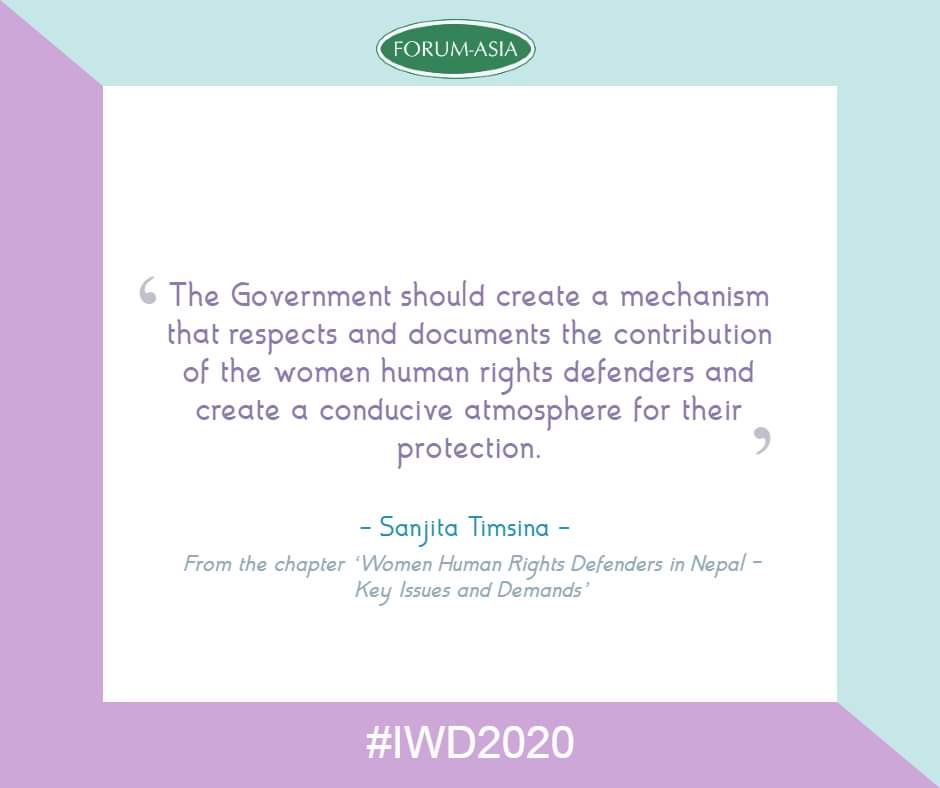In a largely patriarchal society, women human rights defenders in Nepal face life threatening risks and gender-based violence. The Women’s Rehabilitaton Centre (WOREC), as a founding member of the Natonal Alliance of Women Human Rights Defenders Network (NAWHRDN), has been at the forefront of advocatng for women defenders’ rights and freedoms since 2007. In this chapter, WOREC’s years of experiences and refectons are explored, as well as the challenges encountered, lessons learned, and future steps ahead.
Women human rights defenders (WHRDs) are working to advance human rights and fundamental freedoms, ending discriminaton and structural violence. WHRDs in Nepal have aimed at breaking the culture of silence while championing the transformaton of women from victms to change makers. In doing so, as WHRDS we have faced serious discriminaton on the basis of our gender, work and the rights we work for. Our struggle to change patriarchal norms, values and structural violence has culminated in control over our bodies and physical integrity.
We have been targeted, critcised, threatened, intmidated, surveilled, and harassed, including online atacks because of our gender, and the work we do. At least 95% of documented incidents elucidate that to delegitmise our work, WHRDs, including their family members and intmate partners, have been subjected by state and non-state actors to domestc violence, reprisals, death threats, verbal abuses and harassments.1 WHRDs who identfy as lesbian, gay, bisexual, transgender, intersex and queer (LGBTIQ) persons (including trans men), sex workers, women’s health workers, indigenous rights actvists, historically marginalised women’s rights champions, women migrant workers, women impacted by confict and poverty, women with disabilites and users of drugs, are ofen further marginalised by the social stgma they carry, increasing their exposure to violence and threats. Violence against Women (VAW) is a gross violaton of human rights. WHRDs are advocatng to end such violatons by challenging feudal and patriarchal structures, inequality and structural violence. The challenge they present to traditonally constructed norms, values, and practces gets translated into violent atacks on their bodies and minds. They are labelled as ‘troublemakers’, ‘whores’, ‘witches’ and ‘sluts’. Such stgmatsaton is rarely treated with necessary seriousness and contnues to either be ignored or regarded with very low priority. What has to be understood is that this stgmatsaton and the lack of response from the State and Community leaders ofen translates into violent acts aimed at preventng these women from contnuing their human rights work. In September 2017, prominent WHRD Rajkumari Upadhaya was assaulted in her home for over three hours by a neighbour who accused the former of being a witch and of making others ill.2 VAW is an outcome of patriarchal socio-cultural norms and practces, and ofen take places in the private sphere. The ‘culture of silence’ that surrounds these ‘private acts’ makes it difcult to deal publicly with VAW. Silence and the consequent invisibility make it difcult to gather evidence of such violatons. They are the only people who dare to make the violence faced by the victms public, ofen jeopardising their lives and their own security in the process. WHRDs face threats, warnings and ultmatums for their work. They also receive threats against their family members, with kidnapping and murder of their children. Women partcipatng in the public sphere are subject to ‘sexual baitng’ by family members and nonstate actors; they are accused of engaging in extra-marital afairs, being sexually promiscuous, and being bad mothers and women. They are accused of promotng western ideas and of breaking up families. They are also subject to domestc violence, sometmes leading to atempted murder. They have been targeted because they are women and they defend human rights.
Read more:
https://www.forum-asia.org/uploads/wp/2020/03/WP_WHRD_Chapter-on-Nepal.pdf
